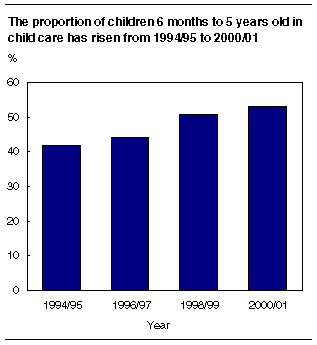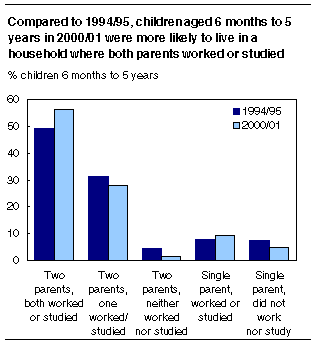
















 |
|
 |                |
Information identified as archived is provided for reference, research or recordkeeping purposes. It is not subject to the Government of Canada Web Standards and has not been altered or updated since it was archived. Please "contact us" to request a format other than those available.

|

Monday, February 7, 2005 Child care1994/95 and 2000/01Over half of Canadian children were in some form of child care by 2000/01 and a quarter of them were in a daycare centre, according to a new analysis. The proportion of children aged six months to five years who were in child care increased significantly between 1994/95 and 2000/01. In addition, during this six-year period, a shift occurred in the type of main child care arrangement used. 
The use of daycare centres, as well as care by a relative, became more popular as main care arrangements than they were in 1994/95. At the same time, fewer children were being cared for in their own home or in someone else's home by a person who was not a relative.
Data from the National Longitudinal Survey of Children and Youth as reported by parents show that in 1994/95, 42% of children aged six months to five years were in some form of child care. Over the subsequent six-year period, the child care rate increased steadily to more than one-half of children (53%) by 2000/01. Of all children in child care in 2000/01, 25% were enrolled in a daycare centre as their main care arrangement, up from about 20% six years earlier. The proportion of children who were looked after in their own home by a relative rose from 8% to 14%. At the same time, the proportion of children who were looked after in someone else's home by a non-relative fell from 44% to 34%. Increase in level of child care in most provincesA significant increase in the level of child care during the six-year period occurred in virtually every province. Furthermore, in some provinces there was a move towards increased use of daycare centres as the main child care arrangement, while in others care in the child's home by a relative increased in popularity. For example, in 2000/01, nearly 61% of children aged six months to five years in Quebec were in some form of child care, up from 44% in 1994/95. Of these children in child care, 41% were attending a daycare centre compared with 25% six years earlier. Conversely, the proportion of children in Quebec who were going to someone else's home for care by a non-relative fell from 43% to less than 34%. The situation was different in some of the other provinces. For example, in Newfoundland and Labrador in 2000/01, 14% of children were attending a daycare centre and 16% were going to someone else's home for care by a non-relative. On the other hand, 29% were being looked after in the child's home by a relative. In Saskatchewan, nearly 54% were going to someone else's home for care by a non-relative in 2000/01. Only 10% of children aged six months to five years in Saskatchewan were attending a daycare centre. Time spent in child care varied provinciallyOverall, the time that children aged six months to five years spent in their main child care arrangement changed little during the six-year period, averaging about 27 hours a week. Nor was there any substantial change during that time within each province. The only exception was Quebec where parents reported their children spent, on average, 30.6 hours in child care in 2000/01, up from 28.5 hours six years earlier. However, there were some interprovincial differences at both time periods. For example, in both 1994/95 and 2000/01, children in British Columbia were below the national average in the time they spent in their main care arrangement. In 2000/01, British Columbia youngsters were in their main child care arrangement for 22.3 hours a week. On the other hand, their counterparts in the Atlantic provinces spent from 26.7 to 31.5 hours a week in their main care arrangement. Child care rates increased regardless of backgroundThe increase in the proportion of children in child care during the six-year period occurred regardless of the children's demographic background. Children experiencing an increase in child care rates included: children aged one to five; children who lived with single- or two-parents; children who were living in lower or higher income households; and children in urban or rural communities. In 2000/01, 85% of children aged six months to five years who lived with a single parent who worked or studied were in some form of child care. This was a significant increase from 78% in 1994/95. Among children who lived in households with two parents who worked or studied, two-thirds (66%) were in child care in 1994/95. By 2000/01, this had increased to nearly 73%. Data show that children in this age group were more likely to live in a household where both parents worked or studied in 2000/01 than they were six years earlier. Moreover, children were less likely to live in a household where their single parent neither worked nor studied. 
Daycare centres were popular among single parents who worked or studiedDaycare centres were a popular main child care arrangement for households with single parents who worked or studied in both 1994/95 and 2000/01. One-third (33%) of children in child care from households with a single working or studying parent were in a daycare centre in 2000/01, virtually the same proportion as six years earlier. An additional 31% of these children were cared for in someone else's home by a non-relative. Again, this was virtually unchanged from 1994/95. The situation was slightly different in the case of children in child care from households where both parents worked or studied. In 2000/01, nearly one-quarter (24%) of children in two working or studying parent households were in a daycare centre, up from 17% six years earlier. By far, children in two working or studying parent households were more likely to be in someone else's home cared for by a non-relative. In 2000/01, some 36% of these children were in this type of main care arrangement, although this proportion was down from 46% six years earlier. Furthermore, care at home by a relative increased in popularity over time. The rate for children from single working or studying parent households in this type of child care more than doubled from 8% in 1994/95 to 18% in 2000/01. The proportion of children from households with two working or studying parents in this type of care increased from 8% to 12%. Children from households consisting of a working or studying single parent spent more time in child care. In 2000/01, these children averaged 32 hours a week in their main child care arrangement, compared with 27 hours for children who had two parents who worked or studied. In a five-day week, this amounted to about 1 more hour of child care each day. Definitions, data sources and methods: survey number 4450. For more information about the data collected during the first four cycles of the National Longitudinal Survey of Children and Youth or to enquire about the concepts, methods or data quality of this release, contact Client Services (1-800-461-9050; 613-951-3321; ssd@statcan.gc.ca), Special Surveys Division.
| |||||||||||||||||||||||||||||||||||||||||||||||||||||||||||||||||||||||||||||||||||||||||||||||||||||||||||||||||||||||||||||||||||||||||||||||||||||||||||||||||||||||||||||||||||||||||||||||||||||||||||||||||||||||||||||||||||||||||||||||||||||||||||||||||||||||||||||||||||||||||||||||||||||||||||||||||||||||||||||||||||||||||||||||||||||||||||||||||||||||||||||||||||||||||||||||||||||||||||||||||||||||||||||||||||||||||||||||||
|
|
|